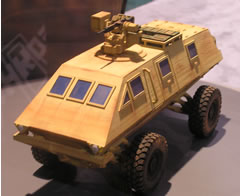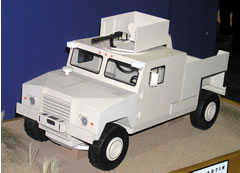The Office of Naval Research has selected General Dynamics Land Systems and Oshkosh Truck to build Joint Light Tactical Vehicle (JLTV) mock-ups and conceptual designs, modeling and simulation to provide tradeoff analysis for the evaluation of future development of such vehicles. Lockheed Martin introduced its team for the program in October 2006. The future family of vehicles will comprise five armored versions, ranging from infantry combat vehicles, command vehicles, reconnaissance, and armored utility vehicles. The contract was announced in August 2006 and the work is expected to be completed during the first quarter of 2007.
 Specifications defined by the services for the JLTV family of vehicles address current capabilities gaps, to increase force protection, survivability, fuel-efficiency, capacity, maneuverability and automotive safety balanced with the total cost of ownership. Vehicles also must meet current weight and dimension requirements for transportability aboard ships and aircraft. In general, JLTV is expected to provide the U.S. Army and Marine Corps with a family of more survivable vehicles and greater payload than the current HMWWV.
Specifications defined by the services for the JLTV family of vehicles address current capabilities gaps, to increase force protection, survivability, fuel-efficiency, capacity, maneuverability and automotive safety balanced with the total cost of ownership. Vehicles also must meet current weight and dimension requirements for transportability aboard ships and aircraft. In general, JLTV is expected to provide the U.S. Army and Marine Corps with a family of more survivable vehicles and greater payload than the current HMWWV.
The future family of vehicles will comprise five “Mission Role” variants: the Combat Tactical Variant, the Command and Control Variant, the Utility Variant, the Light Infantry Squad Carrier Variant and the Reconnaissance Variant. The vehicle family will also include compatible trailers.
 JLTV design will include a basic armor protection package as well as provisions to accommodate an additional add-on armor kit. The vehicle’s power-plant will supply power for all on-board electronic components to enable continuous network-enabled operation. The engine will provide the primary source of electrical power. The power-plant will also be required to provide external power for dismounted users, during extended silent watch. Satisfying these design issues, meeting transportability and mobility requirements, and making this an affordable family of vehicles will require the use of innovative technologies and design strategies.
JLTV design will include a basic armor protection package as well as provisions to accommodate an additional add-on armor kit. The vehicle’s power-plant will supply power for all on-board electronic components to enable continuous network-enabled operation. The engine will provide the primary source of electrical power. The power-plant will also be required to provide external power for dismounted users, during extended silent watch. Satisfying these design issues, meeting transportability and mobility requirements, and making this an affordable family of vehicles will require the use of innovative technologies and design strategies.





















